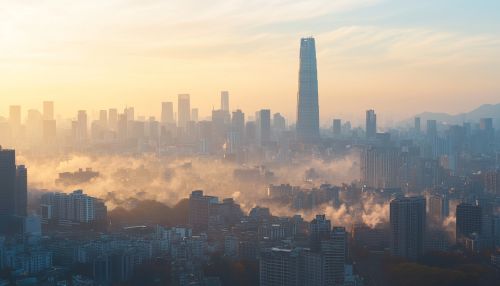Air Pollution in Asia
Introduction
Air pollution in Asia is a critical environmental issue affecting the health, economy, and ecosystems of the continent. As one of the most densely populated regions in the world, Asia faces unique challenges in managing air quality due to rapid industrialization, urbanization, and population growth. This article explores the sources, impacts, and mitigation strategies of air pollution across various Asian countries, providing a comprehensive understanding of the issue.
Sources of Air Pollution
Air pollution in Asia originates from a variety of sources, both anthropogenic and natural. The primary anthropogenic sources include industrial emissions, vehicular emissions, and agricultural activities. Natural sources, though less significant, include dust storms and volcanic eruptions.
Industrial Emissions
Industrial activities are a major contributor to air pollution in Asia. The combustion of fossil fuels in power plants and manufacturing industries releases significant amounts of pollutants such as sulfur dioxide (SO₂), nitrogen oxides (NOₓ), and particulate matter (PM). Countries like China and India, with their rapidly growing industrial sectors, are particularly affected by emissions from coal-fired power plants and heavy industries.
Vehicular Emissions
The transportation sector is another significant source of air pollution in Asia. The increasing number of vehicles on the roads, coupled with inadequate emission control measures, leads to high levels of pollutants such as carbon monoxide (CO), hydrocarbons (HC), and nitrogen oxides. Urban areas in countries like Thailand, Indonesia, and the Philippines experience severe air quality issues due to traffic congestion and outdated vehicle fleets.
Agricultural Activities
Agricultural practices, including the burning of crop residues and the use of fertilizers, contribute to air pollution by releasing ammonia (NH₃) and other volatile organic compounds (VOCs). In countries like Vietnam and Bangladesh, traditional farming methods and the lack of modern agricultural technology exacerbate the problem.
Natural Sources
Natural events such as dust storms, particularly in arid regions like the Gobi Desert, and volcanic eruptions in countries like Indonesia, also contribute to air pollution. These events can transport large quantities of particulate matter over long distances, affecting air quality in regions far from the source.
Impacts of Air Pollution
The impacts of air pollution in Asia are multifaceted, affecting human health, the environment, and the economy.
Health Impacts
Air pollution poses significant health risks to the population. Exposure to pollutants like PM2.5 and ozone (O₃) is linked to respiratory diseases, cardiovascular diseases, and premature mortality. According to the World Health Organization, air pollution is responsible for millions of deaths annually in Asia, with vulnerable groups such as children and the elderly being particularly at risk.
Environmental Impacts
Air pollution also has detrimental effects on the environment. Acid rain, resulting from the deposition of sulfur and nitrogen compounds, damages forests, soils, and aquatic ecosystems. Additionally, pollutants like black carbon contribute to climate change by altering the Earth's radiation balance.
Economic Impacts
The economic costs of air pollution in Asia are substantial. Health care expenses, loss of labor productivity, and damage to crops and infrastructure are some of the direct and indirect costs associated with poor air quality. Countries like South Korea and Japan have invested heavily in air quality management to mitigate these economic impacts.


Mitigation Strategies
Addressing air pollution in Asia requires a combination of regulatory measures, technological innovations, and public awareness campaigns.
Regulatory Measures
Governments across Asia have implemented various regulatory measures to control air pollution. These include setting emission standards for industries and vehicles, promoting the use of cleaner fuels, and establishing air quality monitoring networks. The Clean Air Act in the Philippines and the National Clean Air Programme in India are examples of such initiatives.
Technological Innovations
Technological advancements play a crucial role in reducing emissions. The adoption of renewable energy sources, such as solar and wind power, helps decrease reliance on fossil fuels. Additionally, the development of electric vehicles and the implementation of advanced emission control technologies in industries contribute to improved air quality.
Public Awareness and Community Engagement
Raising public awareness about the health and environmental impacts of air pollution is essential for fostering community engagement and support for mitigation efforts. Educational campaigns and community-based initiatives, such as tree planting and waste management programs, empower citizens to take action in reducing pollution.
Regional Perspectives
Air pollution levels and sources vary across different regions in Asia, necessitating tailored approaches to address the issue.
East Asia
East Asia, particularly China, experiences severe air pollution due to its large industrial base and high population density. The Chinese government has implemented stringent measures to curb emissions, including the closure of polluting factories and the promotion of electric vehicles.
South Asia
In South Asia, countries like India and Pakistan face challenges related to vehicular emissions and agricultural burning. The region's unique meteorological conditions, such as the monsoon, also influence pollution dispersion and concentration.
Southeast Asia
Southeast Asia is affected by transboundary haze pollution, primarily from forest fires in Indonesia. Regional cooperation through organizations like the Association of Southeast Asian Nations (ASEAN) is crucial for addressing this issue.
